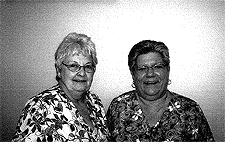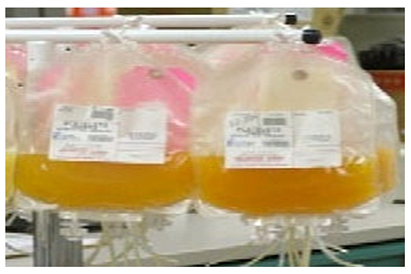 HATS (Hemapheresis And Transfusion Support) has been collecting apheresis platelets since 1972. Since platelets are necessary to prevent excessive bleeding, use in JHH extends mainly to Oncology patients, but also includes patients with aneurysms, organ transplants, hematology disorders, open heart surgery, and victims of traumatic injuries. In FY 08, JHH used 18,734 bags of platelets….95% of them went to Oncology patients. So with a daily use of 50-60 bags of platelets and a shelf life of only five days, apheresis platelets are in constant need.
HATS (Hemapheresis And Transfusion Support) has been collecting apheresis platelets since 1972. Since platelets are necessary to prevent excessive bleeding, use in JHH extends mainly to Oncology patients, but also includes patients with aneurysms, organ transplants, hematology disorders, open heart surgery, and victims of traumatic injuries. In FY 08, JHH used 18,734 bags of platelets….95% of them went to Oncology patients. So with a daily use of 50-60 bags of platelets and a shelf life of only five days, apheresis platelets are in constant need.
APHERESIS VERSUS WHOLE BLOOD PLATELETS: There are two types of platelet products, those derived from whole blood and those from an apheresis platelet collection. What is the difference? Platelet products derived from whole blood require platelets from 6-8 different donors to make up a sufficient product for transfusion. This means the patient is exposed to 6-8 different donors.
An apheresis platelet product will have 6-8 units, making the same amount of product, but, these are all from one donor. So exposure to different donors is greatly reduced! Also, it allows the Platelet Transfusion Coordinators (Dr. Platelet’s) to assign the patient a better matched product. Concern for providing as little risk for the patient as possible is why only apheresis platelet products are used at JHH.
Whole blood is drawn directly into a bag via gravity. Post-collection, it is taken into the lab and separated into components….plasma, red blood cells and platelets. In an apheresis blood collection, whole blood is drawn via an apheresis machine. The blood is separated in the machine, and the platelets are collected while the donor is given back the red blood cells and plasma. It takes one needle stick and approximately 90-120 minutes. The same method can be used to collect apheresis RBC – red cells are collected while plasma and platelets are returned to the donor.
Again, the benefits of an apheresis platelet donation are that it is a quick and efficient way to obtain large quantities of platelets, and it reduces the chance of reaction for the patient. In addition, apheresis platelets provide a large dose of platelets in a small fluid volume, and most importantly (we cannot say this enough), it exposes the recipient to only one donor. Also, all apheresis platelet donors are HLA-typed which allows us to specifically match the product with the recipient (something that cannot be done with whole blood platelets). It is a better, higher quality product.
The benefits for the donor include time to relax by reading or watching a movie and most important, feel the satisfaction all blood donors get for saving a life.
Drawbacks of an apheresis platelet donation are that the donor can become chilled by the room temperature anticoagulant used in the procedure. We provide a heating pad on the chair and blankets to cover the donor should they experience this. Some donors experience tingling of the lips during the procedure which is resolved by pausing the procedure and, if requested, giving the donor two Tums. As with whole blood, you can have bruising at the needle site and can faint.
New technology used in the HATS Blood Donor Center since April 2005 allows apheresis platelets and red blood cells to be collected from one donor at one collection. Back in the 70s, at the start of this program, it took a needle in each arm and about 4 hours to donate, and the device only collected platelets. Apheresis technology has certainly advanced!
REQUIREMENTS FOR APHERESIS PLATELET DONORS: The requirements for an apheresis donor are the same as for whole blood donors, as well as:
- No aspirin (even low dose) for 2 days before donation.
- No non-steroidal anti-inflammatory drugs within 24 hours.
- A good meal before donation with plenty of fluids is suggested.
FREQUENCY OF DONATION: You can donate apheresis platelets every 14 days (RBC can only be donated every 56 days). Platelets may be given safely up to 24 times per year with no adverse effects to the donor. And, you can give platelets between whole blood donations.
WHAT TO EXPECT: What can donors expect when they come to donate:
- A screening like that for whole blood donations: medical history, blood pressure, temperature, pulse, and blood count. A potential donor is asked about current medications, past travel as well as other health-related topics. This form and questions are mandated by the FDA to be sure the donation is safe for the donor as well as the product that is collected is safe for the recipient.
- A cleaning of the intended needle site with iodine preparation.
- A needle insertion with a sterile, single-use needle. Since the sterile needle is used only once and then discarded, you absolutely, positively cannot get AIDS or any other disease from giving apheresis platelets.
- A small bag of blood drawn for testing prior to starting the procedure for laboratory testing.
- One-on-one care from your provider while you are donating. That is right! The staff is with only one donor at a time…during the entire collection.
- Watch a movie, take a nap or just chat with your caregiver.
- A parking pass is provided to cover the cost of parking.
- Post-collection snacks, and sincere gratitude for giving the “gift of life”.
We want your experience to be a pleasant one and one worth repeating!
WHO DONATES BLOOD: Less than 5% of eligible healthy donors donate blood. Statistically, blood donors tend to be more men than women, between 30-50 years of age and above average income. Our experience in the JHH Donor Center is that we have more male than female donors, our donors are between 20 – 65+ years of age, donate once a year to once every 2 weeks, and are 1st time donors to one donor that is about to have his 396th donation!
WHAT HAPPENS TO THE PLATELETS POST-COLLECTION: All blood collected in the Blood Donor Center, stays in JHH and is used for our patients! From the Donor Center the platelets go to Transfusion Medicine for processing and release to a JHH patient.
MAKING A DIFFERENCE WITH YOUR TIME: 4.5 million lives are saved each year with blood donations. So, if you ever wondered if giving blood matters, it does! Giving apheresis platelets is truly the “gift of life” for a patient in need. It allows JHH to offer the best care for every patient who needs it.
LOCATION: The JHH Blood Donor Center is located on the first floor in JHOC, between Express Testing and the Wilmer Eyeglass Store.
If you feel you would like to donate or would like to know more about apheresis blood collections, please call us at 410 955-TIME (8463) or stop by the Donor Center! All donations are by appointment only.
Louanne Morell, Pat Kastel, Dr. Karen King, and the entire Apheresis Staff at the Johns Hopkins Hospital


How long does donation take and what are your hours of operation?
Thanks,
Tony Bilenki
I am a retired attorney and am currently working as the OR pharmacist for the hospital. I am also a 23 year survivor of AML. When I was in the cancer center for treatment I asked fellow professionals to request members of the Maryland Bar associatiion and the Maryland Pharmacists associatiion to donate platelets for me. 300+ members of those associations showed up to donate, overwhelming the apheresis center. Many of them are still donating platelets. Requests to large groups such as these by a member in need will most likely produce the donors that are needed.
I understand that the needle, tubing and collection bags are disposable.
However, the internal unit itself where the blood is separated before being returned is not disposable. How is that part of the machine cleaned to protect the next donor?
How is the internal unit itself where the blood is separated before being
returned is not disposable,how is that part of the machine cleaned to
protect the next donor,I’m thinking of donating and have a worry about this issue.
Please reply